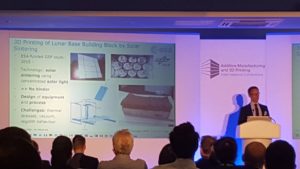 Sometimes when a new technology leaves the laboratory, it goes off to perform its functions in an industrial setting, research facility, or educational institute. Sometimes, though, its installation may be quite literally out of this world — and that’s just what the European Space Agency (ESA) sees as the future of 3D printing.
Sometimes when a new technology leaves the laboratory, it goes off to perform its functions in an industrial setting, research facility, or educational institute. Sometimes, though, its installation may be quite literally out of this world — and that’s just what the European Space Agency (ESA) sees as the future of 3D printing.
During this summer’s International Conference on Additive Manufacturing and 3D Printing in Nottingham, UK, a series of industry and academic professionals spoke to some of the pressing realities of additive manufacturing today — and what it will take for the industry to truly see realizable advances. Representing the ESA, Advanced Manufacturing Process Engineer Dr. Johannes Gumpinger presented a session entitled “Additive Manufacturing: On Earth, On Orbit, On Planet.”
“We want European space industry to be more successful, to be more competitive,” Dr. Gumpinger said as he opened his talk.
 He pointed to the fact that NASA, the United States’ National Aeronautics and Space Administration, is much more widely known on a global scale; the ESA is working to amp up its offerings in aerospace solutions as Europe is at the fore of significant efforts to advance technology in real-world (and off-world) applications. The ESA has gained great experience in incorporating additive manufacturing into its R&D as the agency explores a variety of use cases. Speaking to Dr. Gumpinger recently, I asked how long the ESA has been exploring additive manufacturing as part of its strategic approach.
He pointed to the fact that NASA, the United States’ National Aeronautics and Space Administration, is much more widely known on a global scale; the ESA is working to amp up its offerings in aerospace solutions as Europe is at the fore of significant efforts to advance technology in real-world (and off-world) applications. The ESA has gained great experience in incorporating additive manufacturing into its R&D as the agency explores a variety of use cases. Speaking to Dr. Gumpinger recently, I asked how long the ESA has been exploring additive manufacturing as part of its strategic approach.
“We have been working on Additive Manufacturing for more than 10 years and issued the ESA roadmap on AM in 2015,” he explained.
 During his session at the AM Conference, Dr. Gumpinger dived into AM applications here on Earth, orbiting in space, and on other planetary/celestial bodies. Starting at home, he noted that the ESA examines applications for metal, polymer, and ceramic materials. Use cases for 3D printed useful components included brackets for critical use, as the agency creates parts from a few centimeters to a few meters in scale. Because additive manufacturing is a young technology, certain challenges present themselves in its application. Among these challenges to achieve space quality, Dr. Gumpinger included:
During his session at the AM Conference, Dr. Gumpinger dived into AM applications here on Earth, orbiting in space, and on other planetary/celestial bodies. Starting at home, he noted that the ESA examines applications for metal, polymer, and ceramic materials. Use cases for 3D printed useful components included brackets for critical use, as the agency creates parts from a few centimeters to a few meters in scale. Because additive manufacturing is a young technology, certain challenges present themselves in its application. Among these challenges to achieve space quality, Dr. Gumpinger included:
- Design challenges
- Manufacturing challenges
- Qualification / validation challenges
- Standardisation challenges
“A lot is technically feasible today – it is now the time to make it a reality,” he said.
Turning to these current limitations holding AM advances back, I asked Dr. Gumpinger his thoughts on how the ESA is seeking to address any/all of these pain points.
“As AM is a rather complex technique, any step starting at the design and arriving at qualification/validation must be controlled. Currently available standards already cover single elements of the end to end process, but we believe that further standardisation efforts are needed. The upcoming ECSS standard on Additive Manufacturing will be a significant step towards a holistic approach,” he told me.
In terms of standardization and qualification, the ESA teamed up with the Coventry-based Manufacturing Technology Centre (MTC) to set up the ESA Additive Manufacturing Benchmarking Centre (AMBC) earlier this year. This Centre marks a major step forward for benchmarking as a variety of materials and processes can be standardized, with failures investigated, to establish a verification path.
Moving off-planet and into orbit, Dr. Gumpinger discussed opportunities for 3D printing onboard satellites orbiting Earth, an area of frequent focus these days for additive manufacturing.
“At the moment, this means we look at the International Space Station,” he said. “Why use 3D printing on the ISS? It is the case today that a lot of parts are shipped to the ISS that will never be used, just in case they are needed. It costs tens of thousands of euros for each kilogram sent up.”
The abstract for his session noted:
“Additive manufacturing is also considered for manufacturing objects on board space habitats, which is highly relevant when crew is in need of hardware. By using and recycling polymers and metallic materials brought during the mission, tools can be produced or repaired, without having to ship them from Earth. The design of the required parts can be established on site or sent by engineers from Earth, using common communication media. A 3D printer is already in operation on the International Space Station for polymers, while technology development activities are ongoing to establish metal additive manufacturing equipment on board the Station.”
Indeed, it was in 2014 that we saw the first tool file emailed to space, where NASA astronauts 3D printed a needed wrench onboard the ISS; furthering opportunities such as this to ensure crews are properly equipped at all times with necessary tools, medical equipment, and more is a key aspect of in-space 3D printing efforts. Recycled materials will also be coming into 3D printing play on the ISS next year. Dr. Gumpinger made note of the FDM 3D printer on the ISS, developed through the Italian Space Agency together with Thales, and the metal 3D printer demonstrator, touching on material concerns including safety (metal 3D printing in space needs to use wire raw materials, he explained, as “powders pose a safety concern on the ISS; they couldn’t just have powder bed, it would float around the machine, even if encapsulated. If something goes wrong, it’s very dangerous for the astronauts; this is simply a safety aspect.”). Additional safety aspects of concern for 3D printing in orbit include:
- Sealed container
- Thermal control
- Filtration system
 Moving into AM on planet, Dr. Gumpinger turned to 3D printing on the moon and Mars, areas where the ESA has been optimistic about capabilities and where there has been, he said, “renewed interest for human and robotic exploration beyond low Earth orbit.”
Moving into AM on planet, Dr. Gumpinger turned to 3D printing on the moon and Mars, areas where the ESA has been optimistic about capabilities and where there has been, he said, “renewed interest for human and robotic exploration beyond low Earth orbit.”
The ESA has had in mind plans for a 3D printed moon base for some time, returning to the idea and furthering conceptual plans for full colonization. The agency sees 3D printing on the moon as a step toward the next great move in human space exploration: Mars.He continued, “The moon (and Mars) is the next destination for post-ISS human exploration, with:
- Lunar resources exploitation (volatiles, water, metals)
- Scientific lunar surface exploration (history of solar system)
- Outpost for solar system exploration
The basic concept is: we want to go to the moon.”
“The vision is to go to Mars. In this process, extrusion process being developed, still challenges exist in quite a significant way,” Dr. Gumpinger said.
While the ESA has been exploring the concept of using local materials in 3D printing structures, challenges remain in that “bringing binder to the moon also requires resources in terms of energy and also cost,” as materials typically require a binding agent to adhere layers together. Advances in these processes this spring have seen the successful 3D printing of small structures created with simulated Martian/lunar regolith, as solar sintering leads to an immediate advantage, Dr. Gumpinger noted, of not shipping binder to the moon. Limited resources manufacturing represents a big step forward and area of focus for 3D printing in space.
With work done in additive manufacturing in space and for space-related exploration, the ESA is seeking to lead the way ahead. Europe, Dr. Gumpinger said, needs to be more competitive in space. The question remains: how do they do that? It’s not only via additive manufacturing, of course, as other design processes are being actively looked into. A large R&D program is in place as the agency continues on its path forward.
For a bit more detail regarding their plans, I had one final question for Dr. Gumpinger: How does the ESA’s interest in 3D printing help to position the entity/Europe to be more competitive for space endeavors?
“We believe that AM is suitable to a variety of space products,” he told me. “The technique allows to increase the design freedom, and performance but also to reduce cost and lead time. Typical examples of performance enhancement are mass-reduction or lower part-count number. This has the potential to improve various space products including telecommunication equipment, structures, propulsion elements, mechanisms and others. By establishing AM as a standard manufacturing process for space, European companies can take advantage of it and potentially offer better products for lower costs.”
Additive manufacturing, already impacting space exploration, will continue to play a large role in the years ahead as humanity expands beyond our home planet. The vision at the ESA sees sustainability, necessary and customizable parts on-demand, and on-site building among the key benefits to be had in employing this technology, as Europe works its way to a leadership position in 3D printing on- and off-world.
The ESA has big plans for 3D printing in space; what do you think will come of them? Join the discussion of this and other 3D printing topics at 3DPrintBoard.com, or share your thoughts below.
[AM Conference photos: Sarah Goehrke]
Subscribe to Our Email Newsletter
Stay up-to-date on all the latest news from the 3D printing industry and receive information and offers from third party vendors.
You May Also Like
3D Printing Unpeeled: New Arkema Material for HP, Saddle and Macro MEMS
A new Arkema material for MJF is said to reduce costs per part by up to 25% and have an 85% reusability ratio. HP 3D HR PA 12 S has been...
3D Printing News Briefs, January 20, 2024: FDM, LPBF, Underwater 3D Printer, Racing, & More
We’re starting off with a process certification in today’s 3D Printing News Briefs, and then moving on to research about solute trapping, laser powder bed fusion, and then moving on...
3D Printing Webinar and Event Roundup: December 3, 2023
We’ve got plenty of events and webinars coming up for you this week! Quickparts is having a Manufacturing Roadshow, America Makes is holding a Member Town Hall, Stratafest makes two...
Formnext 2023 Day Three: Slam Dunk
I’m high—high on trade show. I’ve met numerous new faces and reconnected with old friends, creating an absolutely wonderful atmosphere. The excitement is palpable over several emerging developments. The high...





































